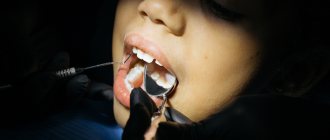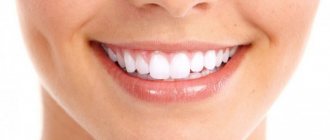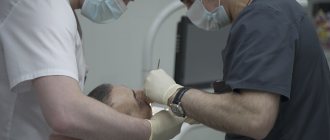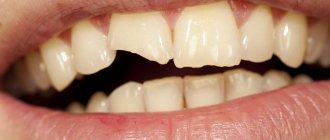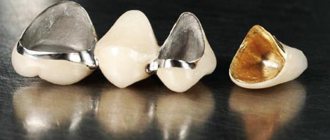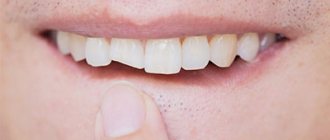Why do teeth rot in adults?
The development of caries and other dental diseases occurs under different circumstances, including:
- Insufficient oral hygiene or its complete absence.
- Poor nutrition, accompanied by the development of excess or deficiency of microelements and vitamins in the body.
- Failure to follow the rules of eating: chewing very cold or very hot food, combining hot and cold, biting into very hard foods.
- Disturbance of metabolic processes in the body.
- Endocrine diseases and temporary hormonal imbalances, due to which the protective properties of saliva are weakened.
- Pathological processes that occur during pregnancy and are associated with the outflow of nutrients from the mother’s body to the developing tissues of the fetus.
- Weak immune activity.
- Hereditary predisposition and improper formation of the dentofacial apparatus.
- The effects of nicotine and alcohol.
- The effect of toxic substances in unfavorable environmental conditions or harmful working conditions.
- Infectious processes due to injuries.
- The presence of untreated infectious processes in any part of the body.
When visiting a dentist, you rarely hear exactly why a particular dental disease has developed. Most often, unfavorable factors act on dental tissues in a complex manner and over a long period of time.
Why do children's teeth rot?
Teeth rot not only in adults, but also in children. In addition to the reasons described, children’s teeth are affected by additional factors that often arise due to the fault of parents:
- Improper nutrition of the mother during pregnancy, due to which the formation of bone and dental tissue of the fetus is abnormal.
- The effect of toxins and medications that enter the mother’s body through smoking, drinking alcohol or self-medicating.
- Long-term use of pacifiers and bottle nipples.
- Night feeding - at night, food particles linger in the mouth for a long time and rot due to the activity of bacteria.
- Late and incorrect teaching of children to maintain hygiene.
- Eating large amounts of sweets, the remains of which create favorable conditions in the mouth for the proliferation of microbes.
Symptoms of dental decay
A person may find out that his tooth has begun to rot too late - when the process of tissue destruction begins to develop in full force and will already cause great harm to the dentin and pulp. The main symptoms of a purulent process are:
- The appearance of stains on the top of the crown or in the cervical area if the root of the tooth rots. If a tooth rots from the inside (from the root canals), then the initial stages of necrosis can only be detected using x-rays: the visible surface of the crown turns black in the later stages of decay.
- Deformation of the tooth surface, the appearance of holes.
- Putrid, rotten odor from decaying tissues, caused by fetid waste products of bacteria that cause the process of decay.
- The appearance of an unusual, unpleasant taste in the mouth due to the entry of pus from the carious cavity or pulp chamber into the oral cavity.
- The appearance and gradual intensification of aching pain.
- Temperature increase.
- Increased accumulation of plaque with pathogenic microflora not only on the dentition, but also on the surface of the tongue or tonsils.
If a tooth has rotted to the root, its crown may completely crumble. Against the background of the destruction of the rotten tooth root, the patient may experience more frequent headaches.
Causes of root damage
The root of a tooth can crumble under the influence of several factors. The most common reasons for damage are:
- injuries,
- inaccurate expansion of root canals, their careless mechanical processing in preparation for filling,
- violation of pin implantation technology,
- uneven distribution of chewing load after installation of the prosthesis,
- complex tooth extraction.
The root can crumble if damaging pressure is transmitted parallel or perpendicular to its longitudinal axis. The most serious damage occurs from impacts and falls from heights.
What are the dangers of rotten teeth, consequences for the body
Many people ignore the process of tooth decay unless it is accompanied by severe pain. But the consequences of the carious process can be unpredictable and dangerous. If you have rotten teeth, the following complications may develop:
- Destruction of bone tissue of the musculoskeletal system.
- Endocarditis is inflammation of the lining of the heart.
- Inflammatory pathologies of the kidneys.
- Infections of ENT organs.
- Psychological complexes due to discomfort during communication and dissatisfaction with the appearance of the dentition.
- Purulent-inflammatory diseases in the gums (abscesses, phlegmons) and, as a result, the spread of infection throughout the body, leading to general intoxication.
The health of baby teeth greatly affects the condition of the permanent buds. Therefore, if nothing is done about the decay of milk dental tissues, in the future the child may have big problems with the formation of a permanent dentition.
Options for restoring a tooth at the root
Today, there are two main methods for restoring the crown of a tooth while preserving its root: direct and indirect. In the first case, the missing part is formed by extension, and in the second, it is manufactured separately in advance. Next, we will consider the most commonly used methods of bone formation restoration.
The pins are made from hypoallergenic and biocompatible materials, so they take root well and do not cause any discomfort to the patient. A crown or filling is placed on the pin. Filling substances rich in fluoride are also actively used. This makes teeth stronger and more resistant to damage. These substances completely imitate the appearance of healthy teeth; they can be selected according to the shade of your enamel.
A core can also be used to reconstruct a broken tooth. It is produced according to individual parameters, taking into account the characteristics of a person’s dentition, which significantly improves the functional properties of the implant. Many patients prefer veneers and lumineers, but this method is only suitable if there is minor damage to the tooth crown. Otherwise, fixing these thin pads will be impossible.
previous post
How to cure a tooth bruise
next entry
What to do if your teeth are rotting
Rot inside the tooth is dangerous for the entire body. Therefore, at the first signs of decay of dental tissues, you should go to the dentist.
Before providing first aid, it is recommended:
- Rinse your mouth with a herbal decoction that has anti-inflammatory and antimicrobial effects. It's better to take chamomile and sage.
- Rinse your mouth with a pharmaceutical antiseptic: Chlorhexidine, Miramistin.
- Thoroughly clean the surface of the dentition to prevent the accumulation of soft plaque and its transformation into hard tartar: bacteria multiply under its surface and spoil the enamel even faster.
- You should not try to remove pus yourself by picking at the enamel with a sharp object. This action will provoke even greater destruction of damaged tissue.
- On the side of the jaw where the rotten tooth is located, it is better not to chew anything so that food does not penetrate into the carious holes.
- After eating, you need to rinse the remaining pieces of food with a weak saline solution or boiled water.
What to do to get rid of the smell
When an unpleasant odor occurs in the mouth, a person most often realizes that the cause is tooth decay, but tries to deal with the problem on his own: rinses the mouth with various pharmaceutical products or infusions made according to folk recipes, tries to kill the bad odor with mouth odorants or chewing gum. If the tooth responds with pain, the person takes painkillers. As a result, tissue decay continues. Then the pain goes away - because the nerve endings die, and the patient believes that a cure has occurred.
The result is tooth loss. It is especially unpleasant if the crown covered a gap in the front row. Now the patient will have to install an implant and crown to maintain the aesthetics of the smile. Therefore, no matter how great the temptation is to let things slide or attempt to cure yourself, remember: dental diseases, especially tooth decay under the crown, cannot be cured at home. All of them require the intervention of a medical professional.
Before visiting the clinic, you can rinse your mouth with tinctures of herbs that have anti-inflammatory properties: a decoction of chamomile, oak bark, calendula. In the hospital, the dentist will determine the stage of tooth decay and perform a series of appropriate procedures. A sick but strong tooth is cured, a damaged one is removed. If there is no inflammation, and the cause of the smell is plaque accumulated in the space between the tooth and the crown, the doctor will clean the tooth of dirt. The crown is then subjected to additional processing to adjust the size and ensure a tight fit to the stump. After this, the prosthesis is fixed with sealing cement.
To ensure hygiene in the oral cavity, if there are one or more dentures, a good solution seems to be the purchase of an irrigator - a device that removes dirt and plaque with a disinfectant solution supplied under pressure. Even hard-to-reach areas that no toothbrush can reach can be cleaned.
Dentists also recommend using dental floss and rinsing your mouth with clean water every time after eating. Various agents with an antibacterial effect are used to rinse the mouth. They are not able to clean plaque from microscopic cracks and gaps between the prosthesis and the tooth stump, but they successfully destroy pathogenic microbes, stopping their life cycle.
If the destruction of cement, loosening of the crown or weakening of the pin occurs during the treatment guarantee, then all actions to restore the quality of the prosthesis are carried out free of charge. Therefore, it is important for the patient to monitor the crown and, if in doubt, contact the clinic where the restoration was made in time.
Install veneers without grinding Luxneers teeth at Dr. Lopaeva’s clinic
Find out more about Luxneers
Treatment in dentistry
Whether a tooth can be treated depends on the severity of the carious process, so doctors first prescribe x-rays to patients. If the situation is not critical and the dentist can save the tooth from rotting, he carefully cleans it of accumulated deposits (plaque and stone) and begins treatment:
- Anesthesia is performed.
- All areas of enamel affected by the carious process are removed, and the rotting pulp must also be removed.
- The dental cavity is washed with an antiseptic.
- The integrity of the surface is restored with filling material. After the filling is installed and hardened, the patient must check the bite: if discomfort is felt, the excess layer of filling material must be removed.
Teeth that are rotting from the gums are treated in the same way, but photopolymer materials are usually used to fill them. They harden quickly, are characterized by increased strength and high aesthetics.
The dentist may prescribe an antibiotic to prevent the infection from spreading throughout the body. For severe pain, an analgesic is prescribed.
There are methods that can be used to prevent damage to dental tissues by cariogenic bacteria. Almost all dental clinics carry out remineralization - strengthening the enamel structure with special preparations. In a hospital or at home, you can perform fluoridation - saturating the enamel with fluoride.
What are the causes of dead tooth formation?
The most common causes of dead tooth formation are primarily caries and mechanical trauma. However, the first reason is much more common. Bacteria that appear during the formation of carious cavities are responsible for tooth death. They produce many toxic substances. These substances then cause gradual and, over time, irreversible damage to the dental pulp. At the first stage, the pulp becomes inflamed and pulpitis occurs. Over time, with the constant deepening of carious cavities, the layer of dentin surrounding the pulp begins to shrink. And harmful bacteria have easier access to attack the pulp. In subsequent stages, pulpitis worsens, which eventually becomes irreversible, after which the pulp dies.
Another reason for the formation of a dead tooth is mechanical trauma. The most common ones include falls, impacts, and knocking out a tooth. This can result in reduced blood flow to the pulp, reducing the availability of all nutrients and oxygen. The cells die, and the pulp irreversibly dies along with them.
Do I need to remove rotten teeth?
If a tooth root or crown is completely rotted, it cannot be restored. Such a tooth cannot be left in the jaw so that its purulent contents do not spread to the surrounding tissues. If there is rot in the root canals, it is not possible to make artificial crowns, since they will not be able to fix on the destroyed tissues. Therefore, in advanced situations, dentists prescribe the removal of a rotten tooth, and this operation cannot be refused. After removal, a course of antibiotics may be prescribed.
To prevent your teeth from rotting, you need to regularly monitor their condition. To maintain dental health, you need to adhere to a nutritious diet and maintain oral hygiene, as well as promptly treat any dental and internal diseases. Purulent processes are extremely dangerous, therefore, if the carious process has reached an advanced stage, you should not refuse to remove the diseased tooth.
How is a completely destroyed tooth removed?
The procedure for tooth extraction is familiar to many from childhood: using special forceps, the surgeon pulls the tooth out of the gum with a trained movement. Of course, an adult will need an anesthetic: removing baby teeth involves much less effort, since the tooth barely stays in the socket. Therefore, the way a decayed tooth is removed for children is not similar to the procedure in a dental office for adults: sometimes it is much more complicated and requires an incision in the gums. The same as in the case of tooth root removal.
Can a dead tooth hurt?
The appearance of pain in a dead tooth depends on the stage at which necrosis progresses. At the very beginning there is usually no pain. During the transitional stage, the already mentioned throbbing toothache may appear. It is a consequence of retention of purulent exudate and usually worsens in a lying position. After its cessation, complete necrosis of the dental pulp occurs.
Pain can also occur as a result of dental treatment. If a dentist places a prosthetic crown that is too large on a tooth, there is a high probability of overloading the tooth and causing periapical changes. In this situation, pain usually occurs during chewing. It can be easily eliminated at your next visit to the dentist by shortening the crown.
How to prevent trouble
It is much easier to prevent this situation than to solve it. Preventive measures are extremely simple. Just follow a few important tips:
- Make it a rule to go to the dentist every six months for preventive examinations.
- At least once a year you should get rid of tartar and accumulated plaque (this is done in the dentist’s office).
- Hygienic measures must be carried out efficiently and regularly (at least twice a day).
- Nutrition should be complete and varied so that the body does not experience a deficiency of beneficial microelements.
- Try to drink only filtered water.
- Stop smoking as soon as possible.
- Carry out dental treatment in a timely manner.
Types of caries in front teeth
Caries on the incisors is classified on several grounds. So, according to the degree of development it is:
- Beginners. An unnatural white spot can be seen on the surface of the enamel, which is a consequence of the leaching of minerals from this area of the tooth. At this stage, caries is treated with the help of remineralization - restoring the balance of minerals in the enamel structure.
- Superficial. If the initial stage of the disease is left unattended, the white spot begins to darken and becomes rough to the touch. There is increased sensitivity to sweet and sour foods, and to cold.
- Average Dark yellow or brown cavities form on the tooth. Their sizes and shapes may vary. Lack of treatment leads to the growth of pathological areas.
- Deep. The last stage of caries, which is accompanied by the destruction of hard tissues. The tooth may break into several pieces. The dark spot spreads over the entire surface of the enamel, penetrating into the dentin, so the painful sensations intensify. A tooth can hurt just like that, without being affected by food or drinks.
It is advisable to get rid of caries on the front teeth at the initial or superficial stage, because it progresses quickly in this area of the jaw.
Types of caries of incisors according to the form of occurrence
According to the form of occurrence, the following types of caries are distinguished:
- Acute: develops rapidly, in 10-14 days the disease passes through the initial, superficial and middle stages.
- Chronic: occurs slowly, gradually destroying the enamel and turning it dark. Caries takes on this form when the main factors that provoked the disease no longer affect the body, but no treatment was provided.
- Multiple: caries occurs in several places on the same tooth or on different teeth.
- Secondary: formed under an installed filling.
In this case, secondary or multiple can occur in both acute and chronic forms. For some people, caries practically does not go away, but does not bother them with pain or other symptoms. However, their teeth slowly deteriorate, increasing the risk of their removal.
Black classification
American dentist Green Black developed his own classification of caries, dividing it into classes:
- 1st class: carious lesions are localized in fissures;
- 2nd class: the pathological focus is localized between the molars;
- 3rd class: caries affects the areas between the incisors and canines;
- 4th class: the disease develops along the edges of the front teeth;
- 5th class: the affected area includes the cervical area;
- 6th grade: caries affects the cutting edges of the front teeth.
During the diagnosis, the doctor determines the degree and type of caries of the front teeth, based on which he selects treatment.
Treatment of caries of anterior teeth in children
Treatment of caries in children and adults follows the same stages. However, children are more difficult to treat because they are afraid of doctors. Parents must properly prepare their child for a visit to the doctor. To relieve fear, experienced dentists turn treatment into a game.
Some parents believe that there is no need to treat baby teeth, since they will fall out anyway. However, this opinion is wrong. Caries can spread to soft tissues and ligaments, which subsequently affects the condition of the molar.
Treatment for severe crown lesions
If caries affects more than 50% of the incisor or canine tooth, it will not be possible to install a filling. After removing the carious areas, the patient is sent to an orthopedist for installation of an orthodontic structure: a bridge, crown, veneer or lumineer. They allow you to hide a cosmetic defect that appears after an illness.
If the tooth is completely destroyed by caries, but the root remains, the doctor installs a pin and a crown. If a tooth is completely lost, an implant will be required. This is one of the most expensive dental procedures.
Diagnostics
It is not always possible to detect caries at the initial stage, since it can be localized on the back side of the tooth. Therefore, dentists recommend coming for an oral examination every six months. During diagnosis, the doctor uses a detector staining method. It allows you to distinguish caries from other similar diseases: fluorosis, enamel hypoplasia, tetracycline teeth, etc.
The dentist can also probe the cavity to assess the nerve's response to exposure. If deep caries is suspected, the patient is sent for an x-ray of the jaw. After the examination, the type of treatment is determined.
What could be the consequences?
Complications and consequences can be disappointing. Losing a tooth is not the worst thing that a rotten tooth can lead to. An abundant accumulation of pathogenic microorganisms often provokes problems with the body and disrupts the functioning of internal organs. Let's consider a number of the most common manifestations:
- Blood poisoning.
- Inflammation of the meninges.
- Constant headaches.
- Sleep disturbance.
- Problems with the gastrointestinal tract.
- Lack or significant decrease in appetite.
- Damage to adjacent teeth.


